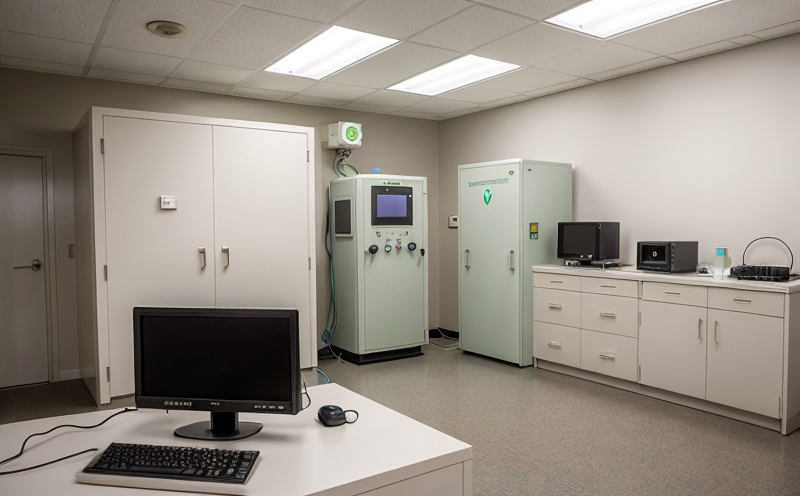ASTM E1708 Radiation Protection Instrumentation Testing
The ASTM E1708 standard specifies a procedure for testing and calibrating radiation protection instruments that are used in environments where ionizing radiation may be present. Compliance with this standard ensures that the devices are accurate, reliable, and safe for use by personnel who work in such settings.
ASTM E1708 is critical because it establishes a consistent method for testing radiation protection instruments like personal dosimeters, area monitors, and survey meters. These instruments play a crucial role in protecting workers from overexposure to ionizing radiation. The standard covers the complete testing process, including the use of reference sources and the interpretation of results.
The procedure outlined in ASTM E1708 includes several key components:
- Testing under various conditions to simulate real-world scenarios
- Use of appropriate reference sources for calibration
- Evaluation of instrument accuracy, repeatability, and stability
- Verification of the instrument's response to different types of radiation (alpha, beta, gamma)
The goal is to ensure that instruments provide accurate readings under all conditions, which directly impacts worker safety. This testing process is essential for organizations in industries such as nuclear power, healthcare, and research facilities where ionizing radiation exposure can be a significant occupational hazard.
ASTM E1708 is widely used by quality managers, compliance officers, R&D engineers, and procurement teams to ensure that the instruments they purchase or use meet the necessary standards. By adhering to this standard, organizations can demonstrate their commitment to worker safety and regulatory compliance.
Why It Matters
The importance of ASTM E1708 radiation protection instrumentation testing cannot be overstated. Accurate and reliable radiation measurement is paramount in environments where ionizing radiation is present, such as nuclear power plants, medical facilities, research laboratories, and industrial settings.
Ionizing radiation can cause significant health risks if not properly controlled. Overexposure to radiation can lead to acute effects like skin burns or radiation sickness, and long-term exposure increases the risk of cancer. Therefore, it is critical that the instruments used for monitoring and protecting personnel are calibrated correctly and perform reliably.
The ASTM E1708 standard provides a uniform method for testing these instruments, ensuring consistency across different manufacturers and facilities. This standardization helps to minimize discrepancies in readings between various devices, which can be crucial during emergency situations or when comparing data from multiple sources.
Organizations that comply with ASTM E1708 demonstrate their commitment to worker safety and regulatory compliance. This is particularly important for industries subject to stringent radiation protection regulations. By ensuring that their instruments meet the rigorous standards set forth in this document, organizations can provide a safer working environment while also avoiding potential legal issues.
In summary, ASTM E1708 testing is essential for maintaining worker safety and regulatory compliance, especially in high-risk environments where ionizing radiation exposure is common. By adhering to this standard, organizations can ensure that their instruments are accurate, reliable, and capable of providing timely and reliable data on radiation levels.
Applied Standards
The ASTM E1708 standard is widely recognized and applied in various industries where ionizing radiation protection is critical. This includes nuclear power plants, medical facilities, research laboratories, and industrial settings. The standard ensures that the instruments used for monitoring and protecting personnel are accurate, reliable, and capable of providing timely and reliable data on radiation levels.
ASTM E1708 specifies a procedure for testing and calibrating radiation protection instruments such as personal dosimeters, area monitors, and survey meters. The standard covers several key aspects:
- Testing under various conditions to simulate real-world scenarios
- Use of appropriate reference sources for calibration
- Evaluation of instrument accuracy, repeatability, and stability
- Verification of the instrument's response to different types of radiation (alpha, beta, gamma)
The standard also includes guidelines for reporting test results and documentation. By following these procedures, organizations can ensure that their instruments meet the necessary standards and are reliable in use.
In addition to ASTM E1708, other relevant standards include:
- ISO 15269: This international standard provides guidelines for the calibration of personal dosimeters used in occupational exposure monitoring.
- IEC 61348-1: This standard specifies performance and test methods for ionizing radiation detectors, including dosimetry systems.
The combination of ASTM E1708 and these other standards ensures a comprehensive approach to radiation protection instrumentation testing and calibration. By adhering to these standards, organizations can provide a safer working environment while also ensuring regulatory compliance.
International Acceptance and Recognition
The ASTM E1708 standard is widely accepted and recognized internationally for its rigorous approach to radiation protection instrumentation testing. This standard has been adopted by numerous countries around the world, reflecting its importance in ensuring worker safety and regulatory compliance.
Nuclear Power Plants: In nuclear power plants, where ionizing radiation exposure can be a significant occupational hazard, ASTM E1708 is used to test and calibrate instruments that monitor radiation levels. This ensures that workers are protected from overexposure and that the plant operates in compliance with international safety standards.
Medical Facilities: In medical facilities where radiation therapy or diagnostic procedures are performed, ASTM E1708 helps ensure that personnel are safe from excessive radiation exposure. The standard is used to test instruments like personal dosimeters worn by medical staff and area monitors placed in treatment rooms.
Research Laboratories: Research laboratories often handle radioactive materials as part of their work. ASTM E1708 ensures that the instruments used for monitoring radiation levels are accurate and reliable, thus protecting researchers from potential hazards.
Industrial Settings: In industrial settings where ionizing radiation is present, such as in mining operations or nuclear fuel processing plants, ASTM E1708 helps ensure that workers are protected from overexposure. The standard is used to test and calibrate instruments like survey meters used for environmental monitoring.
The widespread acceptance of ASTM E1708 reflects its importance in ensuring worker safety and regulatory compliance. By adhering to this standard, organizations can provide a safer working environment while also ensuring that their instruments meet the necessary standards.





